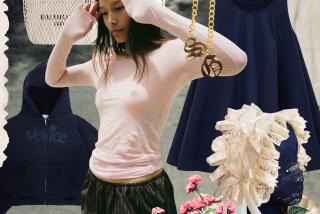When the beach arrived
- Share via
In the mid-1980s, Body Glove’s streamlined neon beach looks burst out of the beach and landed on the runway, capturing the sports-obsessed zeitgeist and turning Redondo Beach into the unlikeliest of fashion epicenters. The amazing rise and fall of the Body Glove bikini was a reflection of fashion’s obsession -- and subsequent repulsion -- with all things fluorescent, a timely tale as brights return for another lap around the pool.
The inspiration for the look came courtesy of fledgling fashion designer Robin Piccone, who approached the Redondo Beach-based surf- and dive-wear company in 1985 with the idea of creating a line of Body Glove swimwear and apparel. Until then, the company had been known primarily for its wet suits, but within a year, Piccone’s designs had launched a fashion cult.
Fascinated by the fabric scraps she found in bins at the company factory, Piccone developed a lightweight version of neoprene, the thermal wet-suit fabric Body Glove had pioneered. The material was cut into sleek neon and black-trim bikinis, corsets and shorts, and adorned with the chunky black zippers and Velcro straps ordinarily meant for wet suits.
The color palette -- a Day-Glo rainbow of shocking pinks, lime green and ultraviolet -- was inspired by the dazzling hues in demand among surfers at the time. (Piccone, though, rarely wore anything but black.)
The 50-piece collection “immediately struck a nerve,” Piccone says, recalling the first time she showed it to editors from Harpers Bazaar, Elle and Vogue. “All the assistants wanted to keep the pieces,” she says. “In the end I had to hide my stuff from them, because I was running out.”
In its first year, Body Glove swimwear found itself simultaneously on the covers of three major fashion magazines. Claudia Schiffer, Linda Evangelista and other sporty supermodels of the era were photographed in Piccone’s designs, and ‘80s uber-blonds Heather Locklear and Heather Thomas both became Body Glove poster girls. Corey Glover, lead singer of the funk metal band Living Colour, took to wearing Body Glove’s neon wet suits on stage, and punk glamour goddess Patricia Field decided to carry their neoprene skirts, blouses and tops at her destination store in Manhattan.
Improbable as it may sound, Piccone, working out of her garage in Venice with two sewing machines, had propelled swimwear into the realm of high fashion.
After a peak that lasted through the late ‘80s, fashion turned to grunge style, deconstruction and the “anti-fashion” movement, which favored a duller palette and a much less healthy demeanor. Body Glove vice president of marketing Scott Daley, a former pro surfer who has been with the company since 1984, noticed the biggest shift after the Los Angeles riots in 1992. Overnight, he says, kids stopped caring about sport and surf and bright colors -- “It became all about hip-hop style and streetwear.”
But Body Glove’s neon ghost continued to lurk around the runway and on city streets for many years after its official fashion demise. It was back in force on the catwalks in fall ’09 lines, and today it’s beach-ready. Why the reprise? Possibly because of the ‘80s music revival, or it could be, as Daley puts it, “because self-expression is coming back.”
“People don’t want to be run of the mill right now,” he says. “It’s impossible to look run of the mill in a chartreuse and teal neoprene wet suit.”
--






